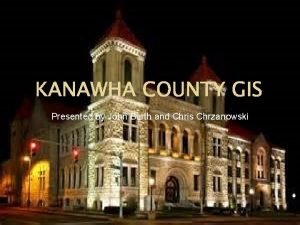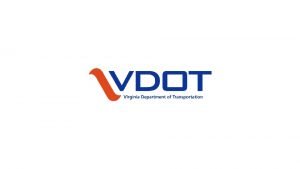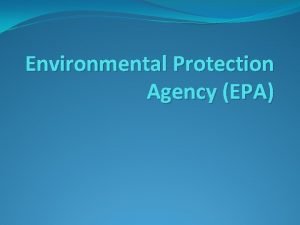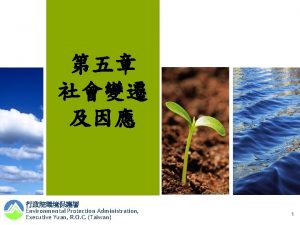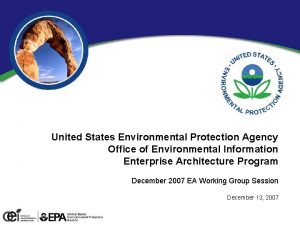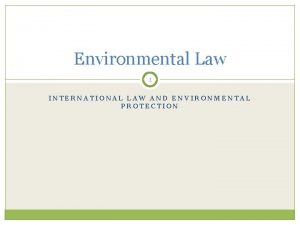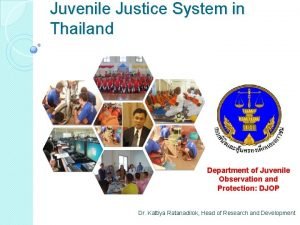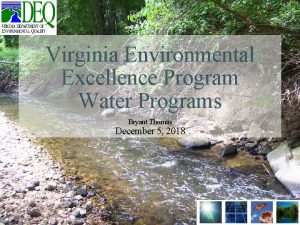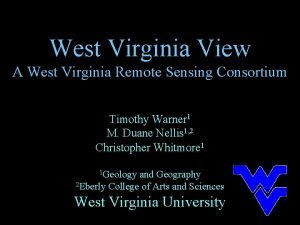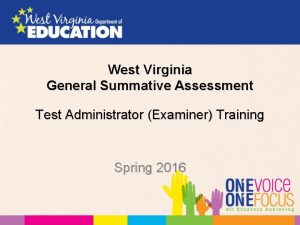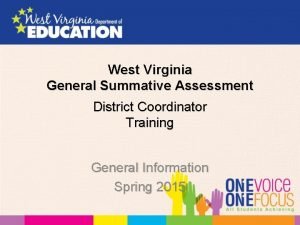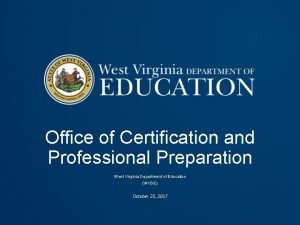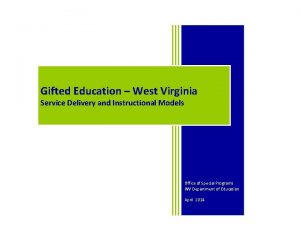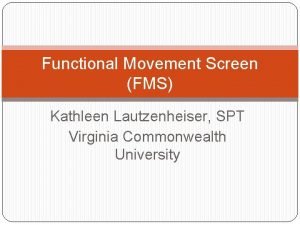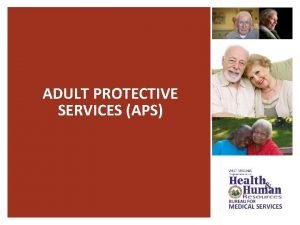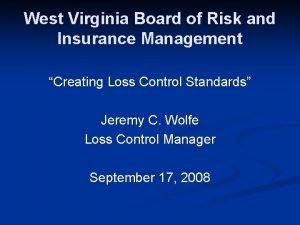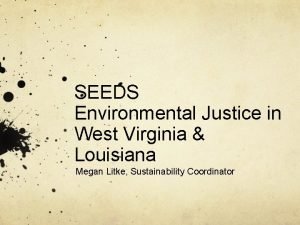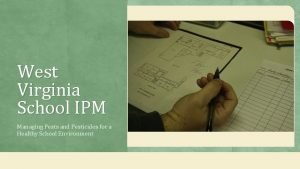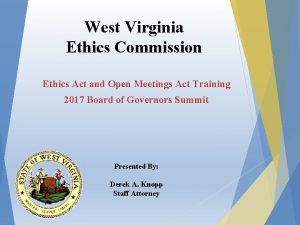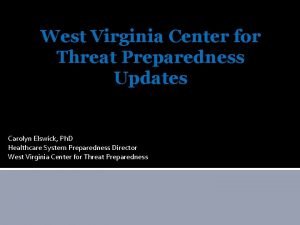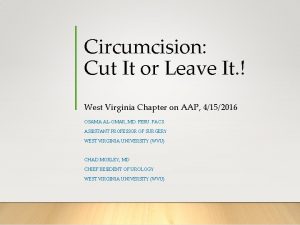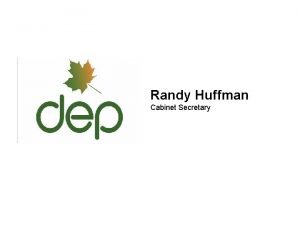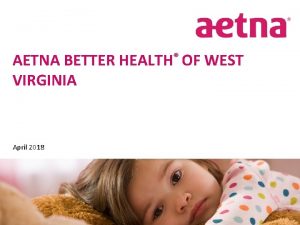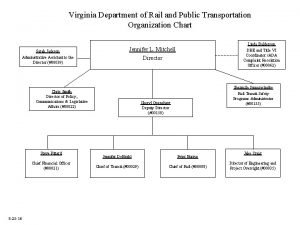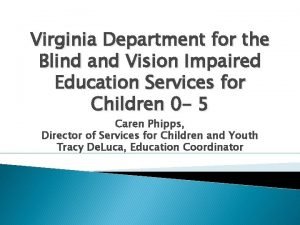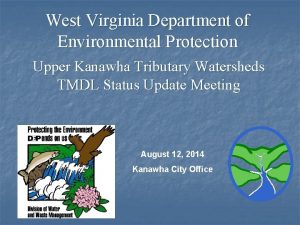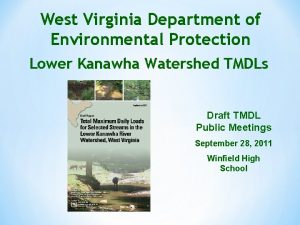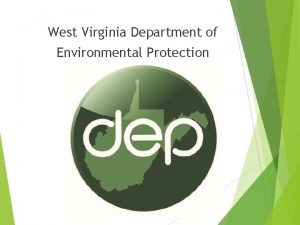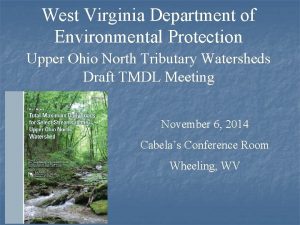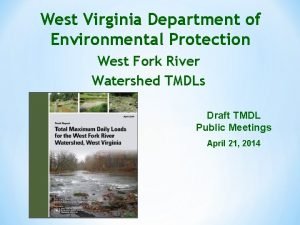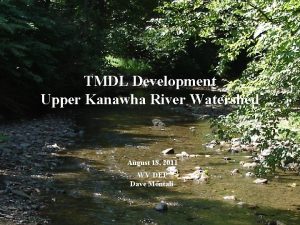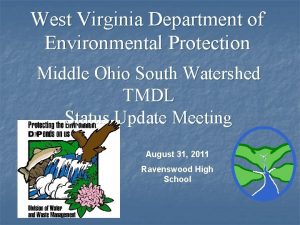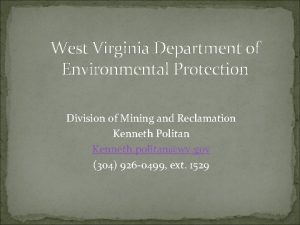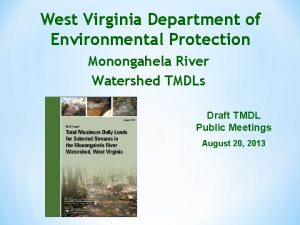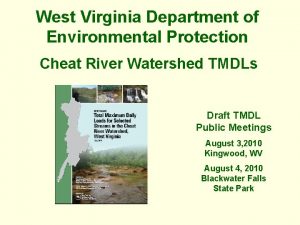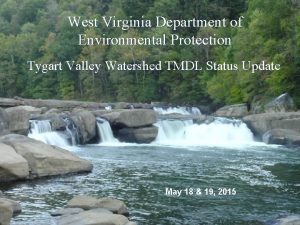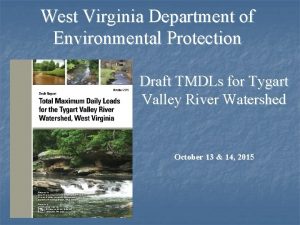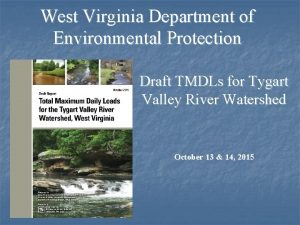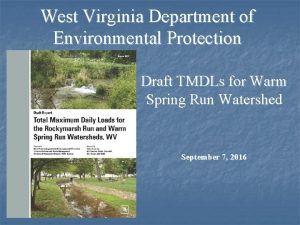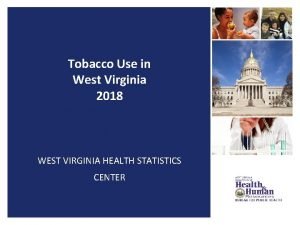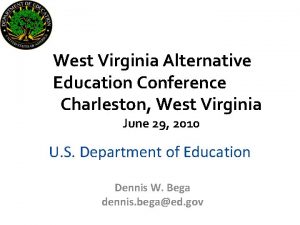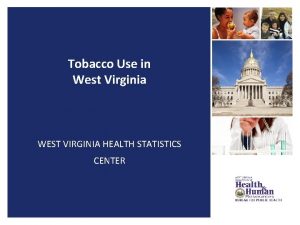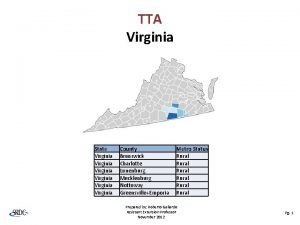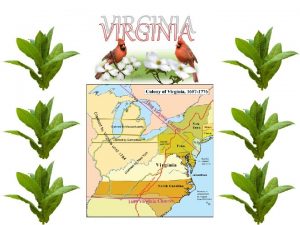West Virginia Department of Environmental Protection Upper Kanawha



































- Slides: 35

West Virginia Department of Environmental Protection Upper Kanawha Tributary Watersheds TMDL Status Update Meeting August 12, 2014 Kanawha City Office

Agenda Ø “Introduction to TMDLs” recap Ø Overview of TMDL Project & Status Ø Overview of Allocation Strategies Ø Discussion – Free form questions and answers

What’s a TMDL? Ø “Total Maximum Daily Load” How much pollutant a stream can receive and remain healthy Ø Pollution Budget - prescribes reductions (where needed) of pollutants that result in the restoration of an impaired stream Ø Ø TMDL development required by Clean Water Act for streams impaired by a pollutant

TMDL = S WLA + S LA + MOS Ø Ø S = “sum of” Ø WLA = “wasteload allocations” LA = “load allocations” MOS = “margin of safety” Ø WLAs - pollutant loads from “point sources” Ø Discharge from point Ø Need NPDES permit LAs - pollutant loads from “nonpoint sources” and background Ø Precipitation/runoff driven Ø No permit required

What’s an impaired stream? Ø Ø Stream that doesn’t meet water quality standards West Virginia Water Quality Standards are codified in 47 CSR 2 Ø Ø http: //www. dep. wv. gov/WWE/Programs/wqs/Documents/Rules/ WVDEP_47 CSR 2_WQS_Final. Rule%206_27_2011. pdf Standards include “Designated Uses“ Uses for WV waters and “water quality criteria” to protect those uses Ø Criteria can be numeric or narrative Ø Impaired streams are enumerated on the 303(d) list

West Virginia Section 303(d) List / Integrated Report

Numeric Criteria of Concern Ø Ø Total Iron Aquatic Life/Public Water Supply Not to exceed 1. 5 mg/l as a 4 day average concentration more than once in a three year period Public Water Supply - 1. 5 mg/l Fecal Coliform Ø Ø Water Contact Recreation/Public Water Supply Shall not exceed 200 counts/100 ml as a monthly geometric mean (5 samples/month) Nor to exceed 400 counts/100 ml in more than 10% of samples in a month

Numeric Criteria of Concern Ø Ø Dissolved Aluminum Ø Aquatic Life Ø Not to exceed 750 ug/l as a 1 hour average concentration more than once in a three year period Ø Not to exceed 750 ug/l as a 4 day average concentration more than once in a three year period p. H Ø Ø Aquatic Life/Water Contact Recreation/Public Water Supply (All Uses) No values below 6. 0 nor above 9. 0.

Numeric criteria of concern Ø Ø Chloride Aquatic Life/Water Contact Recreation/Public Water Supply Not to exceed 230 mg/l as a 4 day average concentration more than once in a three year period Total Manganese Ø Ø Public Water Supply Not to exceed 1. 0 mg/l within a 5 mile zone immediately upstream of a water supply used for public or private consumption

Numeric Criteria of Concern Ø Ø Ø Selenium Aquatic Life/Public Water Supply Not to exceed 20 ug/l as a 1 hour average more than once in a three year period Not to exceed 5 ug/l as a 4 day average concentration more than once in a three year period Public Water Supply - 50 ug/l

Narrative Criteria Previous 47 CSR 2 - 3. 2. i Assessment Ø Based on Benthic Macroinvertebrates (aquatic bugs) Ø Stream scored based on abundance and type of bugs present Ø Streams with impaired communities were placed on the 303(d) list and slated for TMDLs

Narrative Criteria 2012 Legislative Changes Ø Ø Senate Bill 562 passed by the 2012 West Virginia Legislature amended the WV Water Pollution Control Act Requires DEP to develop and secure legislative approval of new rules to interpret 47 CSR 2 -3. 2. i Section 22 -11 -7 b : http: //www. legis. state. wv. us/wvcode/Chapter. Entire. cfm? cha p=22&art=11 No biological TMDLs are part of this effort Ø Streams currently listed as biologically impacted will undergo Stressor Identification process

Stressor Identification Process Ø Ø Ø Method to evaluate stressor/s of biologically impacted streams Process used to evaluate if numeric criteria TMDLs (iron, fecal) will address biological stressors Information will be retained and may be used to delist streams in the future

Impaired Waters Subwatershed Stream Name Code 24 KCode Trout Impairments p. H DO Fe Al Cl Se Mn FC Upper Kanawha Mission Hollow (Venable Branch) WVK-46 KU-3 X Upper Kanawha Chappel Hollow (Chappel Branch) WVK-46 -A KU-3 -A Upper Kanawha Lower Donnally Branch WVK-48 KU-5 Upper Kanawha Pointlick Fork WVK-49 -F KU-6 -F X Upper Kanawha UNT/Pointlick Fork RM 2. 26 WVK-49 -F-4 KU-6 -F-4 X Upper Kanawha Rattlesnake Hollow WVK-49 -I KU-6 -N X Upper Kanawha Georges Creek WVK-50 KU-8 Upper Kanawha New West Hollow WVK-58 -B. 8 -1 KU-19 -R-1 Upper Kanawha Wet Branch WVK-61 -C KU-26 -E Upper Kanawha Longbottom Creek WVK-61 -F KU-26 -N X Upper Kanawha Laurel Fork/Longbottom Creek WVK-61 -F-2 KU-26 -N-5 X Upper Kanawha Coal Fork WVK-61 -H KU-26 -U X Upper Kanawha Laurel Fork WVK-61 -H-1 KU-26 -U-7 X Upper Kanawha Left Fork/Laurel Fork WVK-61 -H-1 -A KU-26 -U-7 -E X Upper Kanawha UNT/Left Fork RM 1. 99/Laurel Fork WVK-61 -H-1 -A-4 KU-26 -U-7 -E-4 Upper Kanawha UNT/Coal Fork RM 4. 63 WVK-61 -H-3 KU-26 -U-18 Upper Kanawha Toms Fork WVK-61 -K KU-26 -AC X Upper Kanawha Tenmile Fork WVK-61 -L KU-26 -AD X Upper Kanawha UNT/Tenmile Fork RM 1. 22 WVK-61 -L-0. 5 KU-26 -AD-1 X Upper Kanawha UNT/Tenmile Fork RM 3. 98 WVK-61 -L-4 KU-26 -AD-9 X Upper Kanawha UNT/Tenmile Fork RM 4. 17 WVK-61 -L-5 KU-26 -AD-10 Upper Kanawha Kellys Creek WVK-64 KU-33 Upper Kanawha Horsemill Branch WVK-64 -A KU-33 -B X Upper Kanawha UNT/Horsemill Branch RM 0. 50 WVK-64 -A-1 KU-33 -B-1 X X Upper Kanawha UNT/Horsemill Branch RM 0. 83 WVK-64 -A-2 KU-33 -B-2 X X Upper Kanawha UNT/Horsemill Branch RM 1. 58 WVK-64 -A-4 KU-33 -B-4 X Upper Kanawha Frozen Branch WVK-64 -B KU-33 -C Upper Kanawha Sugarcamp Branch WVK-64 -C KU-33 -D Upper Kanawha Hurricane Fork WVK-64 -K KU-33 -O Upper Kanawha Goose Hollow WVK-64 -L KU-33 -P Upper Kanawha Cedar Creek WVK-65 -Q KU-39 -AK Upper Kanawha Mossy Creek WVK-65 -Y KU-39 -BM X Upper Kanawha Long Branch WVK-65 -Y-2 KU-39 -BM-7 X Upper Kanawha North Sand Branch WVK-65 -HH-1 KU-39 -DG-2 Upper Kanawha Maple Fork WVK-65 -HH-1 -A KU-39 -DG-2 -A X Upper Kanawha Hughes Creek WVK-66 KU-42 X Upper Kanawha Barn Hollow WVK-66 -B. 6 KU-42 -K X Upper Kanawha Graveyard Hollow WVK-66 -B. 7 KU-42 -L X Upper Kanawha Sixmile Hollow WVK-66 -D KU-42 -Q X Upper Kanawha Bullpush Fork WVK-72 -B KU-55 -F X Upper Kanawha Burnett Hollow WVK-72 -B-2 KU-55 -F-3 Upper Kanawha Riffle Hollow WVK-72 -B-4 KU-55 -F-5 X Upper Kanawha Fourmile Fork WVK-72 -F KU-55 -P X X X X X X X X 43 named streams in Upper Kanawha watershed, Mainstem Kanawha not part of this effort

TMDL Watersheds

MDAS Model Watershed Model Ø Runs dynamically on a 1 -hour time step Ø Represents land use (hydrologic processes) and river processes Ø Can include nonpoint and point sources Ø Streambank Erosion component - Bank Pin Study Ø

Modeling Approach Ø Ø Ø Segment watershed Configure model to represent all sources Calibrate model for hydrology (flow) and water quality Ø Metals Ø Ø Ø Ø Iron Dis. Aluminum Manganese Fecal Chlorides p. H Selenium Sediment Run MDAS for Baseline conditions (existing) Run MDAS for TMDL scenario(s)



Upper Kanawha Watershed Project Status Ø Completed: Ø Next Steps: Ø Monitoring Ø Allocations Ø Source Ø Draft tracking Ø Baseline Ø Bio. Modeling Stressor Ids Ø Status Update Meeting Document Ø Public Ø EPA Meeting Approval

Allocation Methodology Ø Universal Reduction of targeted sources Ø Ø Ø Streambank erosion, Failing Septics, etc Top-down approach Headwater subwatersheds analyzed first Allocation strategy dictates order and magnitude of reduction If necessary, loads are reduced then routed to downstream subwatershed

Allocation Methodology Ø WVDEP priorities: Ensure criteria compliance at all sws outlets Ø Target the primary causative sources Ø Ø Strategy in general Critical conditions must be considered Ø Sometimes only one significant source in sws Ø Always some amount of professional judgement Ø

Fecal Coliform Sources Ø Point sources HAUs Ø Package Plants Ø Municipal Sewage Plant Ø Mining Bathouses Ø MS 4 areas Ø Ø Nonpoint source Failing septic systems and/or straight pipe illicit discharges Ø Stormwater runoff from urban/residential lands Ø Stormwater runoff from agricultural lands Ø

Fecal Coliform Strategy Ø Ø 100% reduction of all untreated sewage discharges (failing septics, straight pipes) as required by WV Bureau for Public Health regulations Sensitivity analysis to address severity of agricultural vs. urban/residential impacts

Iron Sources Ø Streambank erosion Ø Abandoned Mine Lands and seeps Ø Bond Forfeitures Lands and seeps Ø Upland Sediment Sources ØHarvested Forest ØOil and Gas ØAgriculture ØUrban Residential outside MS 4 areas ØRoads Ø Active Mining Ø MS 4 areas Ø Construction Stormwater General Permits

Iron Allocation Strategy Ø Ø Streambank erosion loadings reduced to best available in watershed Sediment sources set to iron loadings equivalent to 100 mg/l TSS Future growth for Construction Stormwater area initially allocated at 2. 5% of subwatershed area AML seeps set to WQ criteria at discharge

Iron Allocation Strategy continued Ø Sensitivity Analysis based reductions, if needed Ø Ø Ø mining permits / bond fortfeiture reduced below baseline sediment sources reduced below 100 mg/l TSS Construction stormwater growth allowance reduced

Dissolved Aluminum/p. H Sources and Strategy Ø Horsemill Br, Sugarcamp Br, Cedar Crk Ø Sources AML Ø Active Mining Ø Ø Strategy Evaluate effects on p. H and Al(d) of any concurrent iron TMDLs being developed Ø Add alkalinity to counter acid effects of AML seeps, and evaluate Al(d) attainment Ø Sensitivity – increase alkalinity and/or reduce aluminum to attain both p. H and Al(d) criteria Ø

Chloride Sources & Strategy Ø Source Ø Certain permitted mining discharges Ø Reductions Ø Mining Strategy outlets – Ø Reduce problematic point source discharges to criteria at end of pipe (230 mg/l)

Manganese Sources & Strategy Ø Ø Horsemill Branch & Sugarcamp Branch (Kelly Creek) are impaired for manganese based on proximity to drinking water intake Sources Ø Ø Ø Bond Forfeiture AML Strategy Ø Ø AML seeps reduced to water quality at end of pipe Evaluate contribution from Bond Forfeiture sites and reduce as necessary

Selenium Sources and Strategy Ø Sources Ø Ø Certain permitted mining discharges Strategy Reduce discharges from instream structures and large volume continuous discharges to criteria Ø Reduce on-bench outlets as necessary to attain criteria at all subwatersheds Ø

WVDEP TMDL Process (4 yrs) Ø Stream Selection - (4/2011) Ø Pre-TMDL monitoring, source identification and characterization - (7/2011 – 6/2012) Ø Contract to model water quality and hydrology – (1/2013) Ø Determine baseline condition and allocate pollutant loads Ø Draft Report development Ø Finalization and EPA approval

Upper Kanawha Watershed TMDL Path Forward Ø Ø Ø Allocate loads and wasteloads and develop draft report Formal public comment period and public meeting on the draft TMDLs in Fall 2014 Address comments, prepare final draft and submit to EPA for approval (final draft will include Response Summary)

Contact Information Ø Ø Comments should be submitted to Steve Young at Stephen. A. Young@wv. gov (10 meg limit for email) Questions - contact Dave Montali, Jim Laine, Mike Mc. Daniel Ø Ø (304) 926 -0499 David. A. Montali@wv. gov, James. C. Laine@wv. gov, or Michael. L. Mc. Daniel@wv. gov

Discussion/Questions. . .
 Nyc department of environmental protection
Nyc department of environmental protection Kanawha gis
Kanawha gis Work area protection manual
Work area protection manual Vdot work area protection manual
Vdot work area protection manual Northern virginia seo audit
Northern virginia seo audit Environmental protection agency purpose
Environmental protection agency purpose Environmental protection
Environmental protection Environmental protection agency
Environmental protection agency Law on environmental protection
Law on environmental protection Department of juvenile observation and protection
Department of juvenile observation and protection Virginia environmental excellence program
Virginia environmental excellence program West virginia view
West virginia view Wvu office of the registrar
Wvu office of the registrar West virginia summative assessment
West virginia summative assessment Wvde tide portal
Wvde tide portal Wvde form 39
Wvde form 39 Characteristics of gifted students
Characteristics of gifted students Deep squat corrective exercises
Deep squat corrective exercises Aps west virginia
Aps west virginia Board of risk and insurance management
Board of risk and insurance management West virginia to louisiana
West virginia to louisiana Po box 67450 phoenix az 85082
Po box 67450 phoenix az 85082 Fumigation west virginia
Fumigation west virginia West virginia ethics commission
West virginia ethics commission West virginia center for threat preparedness
West virginia center for threat preparedness Circumcision
Circumcision West virginia
West virginia Unicare
Unicare West virginia budget
West virginia budget Randy huffman west virginia
Randy huffman west virginia Aetna better health of wv provider phone number
Aetna better health of wv provider phone number West virginia energy code
West virginia energy code Virginia department of agriculture and consumer services
Virginia department of agriculture and consumer services Virginia department of historic resources database
Virginia department of historic resources database Virginia department of rail and public transportation
Virginia department of rail and public transportation Virginia department for the blind and vision impaired
Virginia department for the blind and vision impaired

